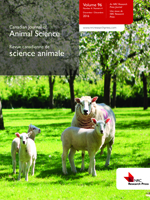Kononoff, P. J., Defoor, P. J., Engler, M. J., Swingle, R. S., James, S. Y., Deobald, H. M., Deobald, R. L., Woronuk, G. N. and Marquess, F. L. S. 2015. Performance and carcass characteristics when sorting feedlot cattle on the basis of phenotype, and leptin genotype along with differential use of β-adrenergic agonists. Can. J. Anim. Sci. 95: 455-463. Crossbred steers were used in a randomized complete block design to evaluate a feedlot cattle sorting system. The sorting system combined information on live body weight, ultrasound fat thickness, coat color, and genotype on the leptin R25C genotype. Using described sorting criteria, a total of four groups (Groups 1-4) of cattle were created along with a randomly selected unsorted control (Group 5), with Groups 1 through 5 representing experimental treatments, and placed in one of five pens within each block. Block was replicated 10 times thus n equaled 50. All cattle were administered zilpaterol hydrochloride except Group 3, which we hypothesized would have a greater proportion of cattle reaching a higher value Quality Grade, and as a result administered ractopamine hydrochloride. The initial body weight of cattle was similar (P=0.426) between the control Group and Groups 1-4. Initial fat, as measured by ultrasound, was also observed to be similar (P=0.256) between these two groups. Overall, when cattle included in Groups 1-4 were compared with Group 5, hot carcass weight was greater (P=0.040), while the proportion of excessively heavy weight carcasses was less (P=0.049). Additionally, hot carcass weight gain tended (P=0.096) to be higher for Groups 1-4 compared with Group 5. No differences (P≥0.129) were observed for calculated yield grade. On average, cattle included in the Sorting Groups 1-4 returned $23 more per head than those in Group 5.
How to translate text using browser tools
13 May 2015
Performance and carcass characteristics when sorting feedlot cattle on the basis of phenotype, and leptin genotype along with differential use of β-adrenergic agonists
P. J. Kononoff,
P. J. Defoor,
M. J. Engler,
R. S. Swingle,
S. T. James,
H. M. Deobald,
J. L. Deobald,
G. N. Woronuk,
F. L. S. Marquess
ACCESS THE FULL ARTICLE
It is not available for individual sale.
This article is only available to subscribers.
It is not available for individual sale.
It is not available for individual sale.





